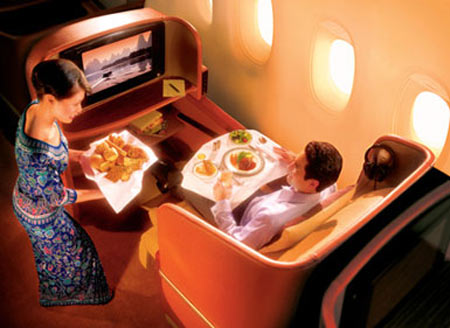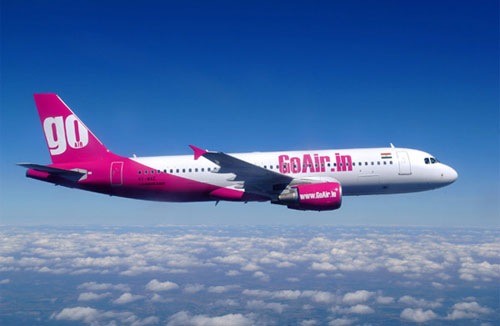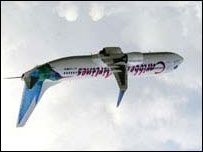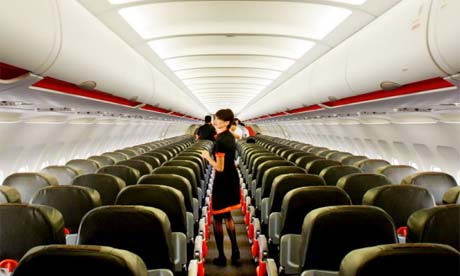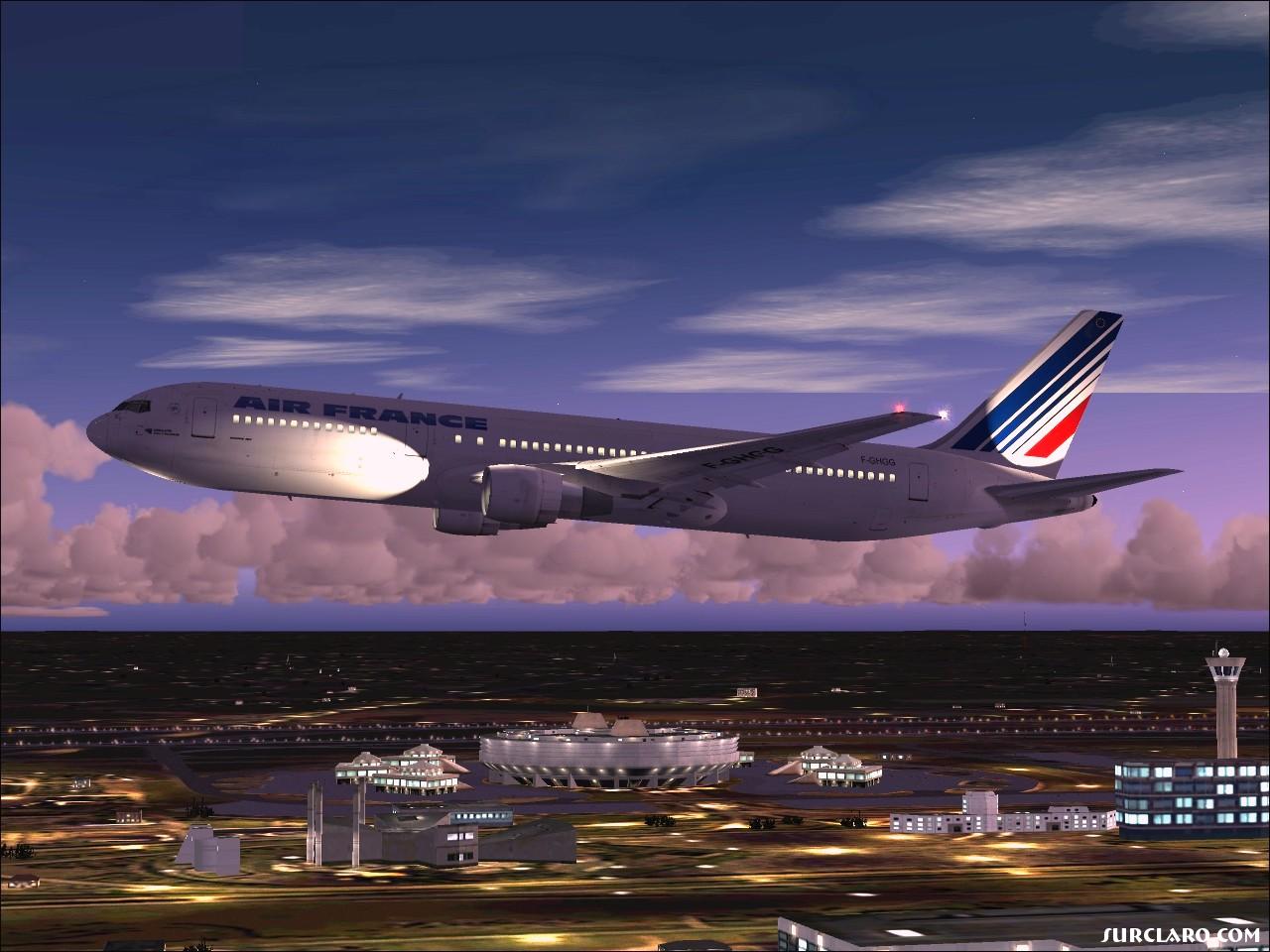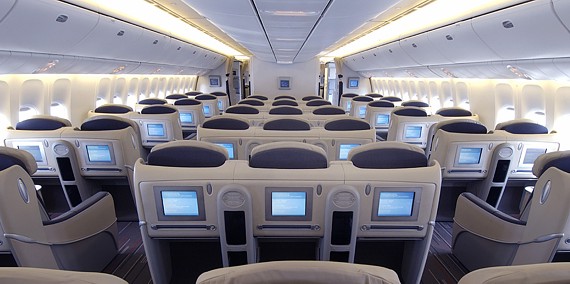During the winter months, runoff from waste water contaminated with glycol is produced when planes are de-iced. In the winter of 2005 – 2006 the waste water contaminated with glycol was collected and stored at various locations at Schiphol airport. The concentrations of glycol varied from 3% to 10%. In the past, waste water containing glycol was discharged to external treatment plants. Schiphol no longer regards this as desirable and has contacted Evides Industrial Water in connection with this specific waste water problem. As the operator of the existing Schiphol waste water treatment plant located at Schiphol-Oost, Evides was happy to work on developing a solution to this waste water problem.
Picture of an airplane
Action plan
Evides Industrial Water conducted market research on the possible techniques for treating waste water contaminated with glycol. In the United States and Canada, concentrators are widely used for the physical treating of such water. Evides Industrial Water presented an action plan to Schiphol that calls for using a concentrator to concentrate water containing glycol into an end product that can be used as a raw material for industrial processes. Killfrost type 2, the de-icing product used during the winter of 2005/2006, contains additives, including polymers. The type 2 de-icer is used at Schiphol because of the longer distances plans must taxi to reach the runways for takeoff. Inland Technologies, which supplies the concentrator, had no experience with this type of de-icing product. Inland Technologies saw the effects of the additives in the type 2 de-icer as a problem in terms of clogging and dirtying, and because of this could not guarantee that operations would be done efficiently and economically. It was necessary to pre-treat the de-icer before use to remove the polymers.
Pre-treatment and test location
Prior to a full-scale test, the de-icer was subjected to ultra-filtration to separate out the polymers. On the basis of financial and operational considerations, this pre-treatment was not selected. On the basis of robustness of technology and lower operating costs, a coagulation/flocculation pre-treatment was selected. During the period from May until September of 2006, a glycol concentrator for pre-treatment was erected on the Schiphol grounds and the full-scale test was performed. The treatment capacity of the installation was approximately 20 cubic metres daily, depending on the glycol concentration in the waste water. The amount of runoff of wastewater contaminated with glycol is strongly influenced by weather conditions. In the winter of 2005/2006, approximately 10,000 cubic metres of waste water contaminated with glycol (in both high and low concentrations) were produced. The high concentrate was worked up with the concentrator and the low concentrate was treated biologically in the aerating ponds built by Schiphol.
Conclusions
During the period from May until September of 2006, Evides Industrial Water was commissioned by Schiphol to operate the concentrator for pre-treating. The following results were achieved:
- Treating of the waste water contaminated with glycol is feasible using a combination of the concentrator and a coagulation/flocculation pre-treatment.
- The end product is of a commercial quality and will be used subsequently as a raw material in industrial processes.
- Following an aerobic post-treatment, the residual product is suitable for discharge to surface water.
And further
Evides has been awarded a subsequent contract by Schiphol to continue operating the concentrator and the aerating ponds for the coming year.
|
|
|---|
|
|
|---|
Tuesday, July 27, 2010
Monday, July 26, 2010
airlines uniform pictures
Starting with the first of the year, Czech Airlines' (ČSA) staff greets its customers in their new uniforms. After more than 9 years, the national carrier had decided to change the design of its uniforms and its two-and-a-half-thousand employees are about to get a new elegant look. The new uniforms and their accessories are in the airline's colours – blue, red and white – and it is hoped that their bold designs will make it easier for passengers to identify the staff that is taking care of them during their air travels. The domestic apparel manufacturer OP Prostějov was the winning bidder in the spring 2005 tender for the supply of these new uniforms. After more than 9 years using the existing uniforms, ČSA decided to give its staff a new appearance and announced a tender for a new supplier in the spring of 2005. Of the four participating bidders, the review committee determined that OP Prostějov, a Czech manufacturer of women's and men's apparel with a long tradition, had come up with the most favourable bid. The winning bidder proposed a new uniform collection that would not only be elegant and stylish but also one in which special attention would be paid to the materials used to make the uniforms. "When creating this new collection, we used the latest European knowledge and expertise in the area of production technologies. Because of the strict demands for the durability and ease of maintenance of the materials to be used, we finally opted for nanotechnology based fabrics. Similar fabrics were also used by the famous French designer Christian Lacroix in his collection of uniforms designed for Air France," said Bořivoj Klug, head of design and sales for corporate identity projects at OP Prostějov. Besides choosing a new elegant design, the selection of the new uniforms also involved considerations such as the comfort and any health impact on the wearer, water resistance, durability, a wrinkle-free appearance, colour fastness and tear resistance. The initial designs for the uniforms underwent several months of testing in all primary operating areas of the company's operations. Description of the New Uniforms The main element of the uniform is a dark blue suit evoking a natural air of authority and professionalism. The rudimentary appearance of the blue colour is softened with red accents, which give the uniform a dynamic look and make it visible in crowded airport environments. A variety of accessories are also used to differentiate between the different staff positions. Pilots wear a gold-coloured necktie and the staff of VIP services wears uniforms with silver-coloured accessories. The designers paid a great deal of attention to even the smallest details and the decorative aspects of the new designs. An important decorative element is the diamond shaped symbol, the primary graphic identity logo for Czech Airlines. Its shape can be seen in the lines of the uniforms' cut, on the printed design on the scarves, shirts and on the buttons for the jackets. The sparkling Swarovski stones that decorate the women's jacket pockets have also been a successful part of the new designs. Czech Airlines introduced its first uniforms back in the 1920's, shortly after the start-up of the airline. The use of uniforms slowly spread from pilots to stewards and, by today, the use of uniforms includes check-in staff, ticket agents, security officers, technicians and other ground service workers. The new collection from the workshop of OP Prostějov features not just a modern design and cut for both men and women and people of different ages but most importantly, a standardized type of uniform for all airline staff that are in regular contact with our customers.  airlines uniform
airlines uniform
 airlines uniform
airlines uniformSaturday, July 24, 2010
Monday, July 19, 2010
Virgin Nigeria opb LatCharter
Thursday, July 15, 2010
indian airlines wallpapers
Air India is one of the world’s great airlines and flies to one of the world’s great countries! With a modern fleet of jet aircraft which is being rapidly updated and the recently completed merger with the domestic carrier Indian Airlines, the decade ahead is likely to be a good one for the national carrier of one of the world’s fastest growing economies. As a way to start you journey to a land we guarantee you will fall in love with, Air India gives you a taste of what is to come!
vt-esg
Alternative Airlines aims to bring you up to date airline news about the airlines which don’t hit the headlines outside of their own country. These airline news stories contain brief details about new airlines, new routes, new frequencies, flights to new destinations and from new cities or airports. Where airlines are being taken over or are merging, we will try to report this airline news from how it will affect you, the passenger. We hope that this airline news section will enable to get a flavour of how smaller airlines are reacting to constantly changing market conditions and help you make a more informed choice of airline.
vt-esg
Alternative Airlines aims to bring you up to date airline news about the airlines which don’t hit the headlines outside of their own country. These airline news stories contain brief details about new airlines, new routes, new frequencies, flights to new destinations and from new cities or airports. Where airlines are being taken over or are merging, we will try to report this airline news from how it will affect you, the passenger. We hope that this airline news section will enable to get a flavour of how smaller airlines are reacting to constantly changing market conditions and help you make a more informed choice of airline.
Wednesday, July 14, 2010
Tuesday, July 13, 2010
big airlines pictures
Traditional airlines such as British Airways and Australia's Qantas could join their low-cost rivals in charging passengers for baggage check-in and food amid soaring oil prices, a leading industry executive warned today.
The head of one of the world's biggest airline alliances, oneworld, whose members include BA and Qantas, said the group will consider changing membership rules in order to allow budget airline-style charges.
"If the industry moves to a standard of charging for an apple juice in economy, the alliance will move in that direction," said John McCulloch, oneworld's managing partner. Asked if bag check-in charges are also on the horizon, he added: "Airlines would argue that it's the right way to do it. It's £20 a bag, £10 for a meal. We are going to see much more of that."
Add-on fees for stowing bags and refreshments are a staple of the budget carrier industry, but long-established airlines have refused to levy such charges in case they lose out to competitors.
Echoing the comments of BA boss Willie Walsh last month, he said fares will also have to rise if carriers are going to stay in business. With oil trading at $130 a barrel, the vast majority of airlines including BA are technically unprofitable. BA and Virgin Atlantic have hiked fuel surcharges over the past week in a bid to cover their costs.
"It is unsustainable. Airlines are going to have to find some way of combating this fuel price, whether it's increasing fares or cutting costs, because the business is unsustainable today." He added: "People have realise that it's going to get more expensive to travel."
Silverjet, the Luton-based transatlantic carrier, became the latest airline to enter administration due to financial problems last week, joining eight US airlines and two carriers that operated flights from the UK: Nationwide Airlines and Oasis Hong Kong Airlines. BA, Qantas and Air France-KLM have all warned in recent weeks that fares will have to rise, but McCulloch warned that consumers might refuse to travel, and plunge carriers into further trouble, if ticket prices rise too far.
"Fares have to rise to a realistic level to reflect the fuel price. Whether that can happen without the industry breaking up is the key question."
McCulloch, apeaking at the annual general meeting of the International Air Transport Association in Istanbul, added that the 10 oneworld airlines, which include Hong Kong-based Cathay Pacific, Spain's Iberia and the world's largest carrier, American Airlines, will have to cooperate more closely on buying fuel. Fuel accounts for around a third of airline budgets and that proportion is rising, with the price of jet fuel rising by 50% since January alone. McCulloch admitted that regulatory authorities in Australia, the US and Europe will watch the talks closely, but the industry has no choice other than to work harder on reducing costs together.
"We have got a procurement group and we have got to be a little more aggressive. With fuel at its current price, it's not acceptable that we cannot work together to make some savings. The irony is that the people selling it [the Opec group] are allowed to sell together. But we will be looking at making sure we don't go to jail," he said.
McCulloch added that ownership laws, which restrict foreign carriers to 25% of the shares in US airlines and in the European Union to 49%, will have to change as airline industry focuses on mere survival over the next year. Unions will also have to give concessions, he said. Two major US carriers, United Airlines and Delta, have dropped merger talks due to union concerns and American Airlines and close rival Continental have also cooled discussions.
"We are structured in a way that, one could argue, adds unnecessary cost. There are attitudes towards ownership and labour that are historical and unsustainable," he said, adding that setting up an airline at Heathrow airport now faces significant obstacles due to trade union
The head of one of the world's biggest airline alliances, oneworld, whose members include BA and Qantas, said the group will consider changing membership rules in order to allow budget airline-style charges.
"If the industry moves to a standard of charging for an apple juice in economy, the alliance will move in that direction," said John McCulloch, oneworld's managing partner. Asked if bag check-in charges are also on the horizon, he added: "Airlines would argue that it's the right way to do it. It's £20 a bag, £10 for a meal. We are going to see much more of that."
Add-on fees for stowing bags and refreshments are a staple of the budget carrier industry, but long-established airlines have refused to levy such charges in case they lose out to competitors.
Echoing the comments of BA boss Willie Walsh last month, he said fares will also have to rise if carriers are going to stay in business. With oil trading at $130 a barrel, the vast majority of airlines including BA are technically unprofitable. BA and Virgin Atlantic have hiked fuel surcharges over the past week in a bid to cover their costs.
"It is unsustainable. Airlines are going to have to find some way of combating this fuel price, whether it's increasing fares or cutting costs, because the business is unsustainable today." He added: "People have realise that it's going to get more expensive to travel."
Silverjet, the Luton-based transatlantic carrier, became the latest airline to enter administration due to financial problems last week, joining eight US airlines and two carriers that operated flights from the UK: Nationwide Airlines and Oasis Hong Kong Airlines. BA, Qantas and Air France-KLM have all warned in recent weeks that fares will have to rise, but McCulloch warned that consumers might refuse to travel, and plunge carriers into further trouble, if ticket prices rise too far.
"Fares have to rise to a realistic level to reflect the fuel price. Whether that can happen without the industry breaking up is the key question."
McCulloch, apeaking at the annual general meeting of the International Air Transport Association in Istanbul, added that the 10 oneworld airlines, which include Hong Kong-based Cathay Pacific, Spain's Iberia and the world's largest carrier, American Airlines, will have to cooperate more closely on buying fuel. Fuel accounts for around a third of airline budgets and that proportion is rising, with the price of jet fuel rising by 50% since January alone. McCulloch admitted that regulatory authorities in Australia, the US and Europe will watch the talks closely, but the industry has no choice other than to work harder on reducing costs together.
"We have got a procurement group and we have got to be a little more aggressive. With fuel at its current price, it's not acceptable that we cannot work together to make some savings. The irony is that the people selling it [the Opec group] are allowed to sell together. But we will be looking at making sure we don't go to jail," he said.
McCulloch added that ownership laws, which restrict foreign carriers to 25% of the shares in US airlines and in the European Union to 49%, will have to change as airline industry focuses on mere survival over the next year. Unions will also have to give concessions, he said. Two major US carriers, United Airlines and Delta, have dropped merger talks due to union concerns and American Airlines and close rival Continental have also cooled discussions.
"We are structured in a way that, one could argue, adds unnecessary cost. There are attitudes towards ownership and labour that are historical and unsustainable," he said, adding that setting up an airline at Heathrow airport now faces significant obstacles due to trade union
Wednesday, July 7, 2010
Subscribe to:
Posts (Atom)
|
|
|---|















 airlines uniform
airlines uniform

